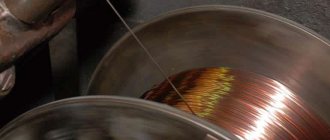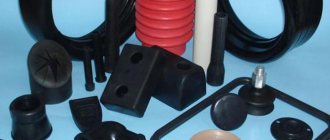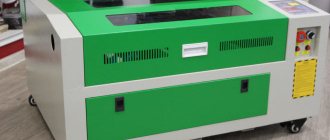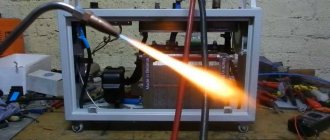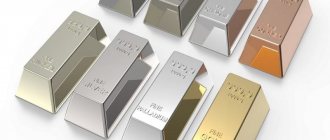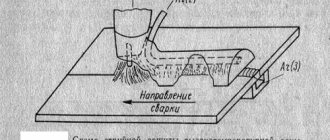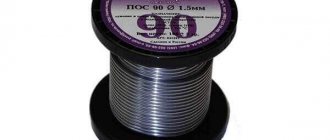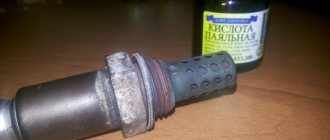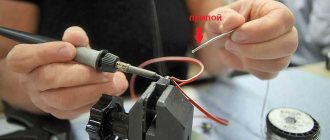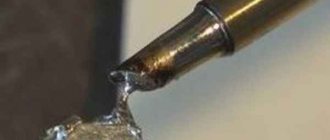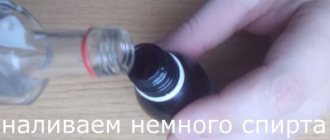Industrial soldering of cast iron is considered a labor-intensive and tedious task, which is explained by the peculiarities of the structure of the melted material. Cast iron is characterized by the presence of graphite in its composition, which limits the access of solder to the surface.
In this regard, before starting soldering work, this material must undergo sandblasting. Upon completion of this procedure, welding (soldering) of cast iron is noticeably easier, since practically no graphite remains on its surface.
At low temperatures
With the low-temperature method of melting cast iron, its surface is subjected to pre-treatment, for which a special flux is used.
In addition to flux treatment, an electrochemical method can be used, which consists of placing cast iron blanks in special salt baths. Upon completion of these operations, the surface prepared for soldering is degreased with acetone.
For high-quality degreasing of cast iron before soldering, an alkali solution or aviation gasoline can also be used.
To process the prepared material, you will need one of two tools:
special soldering iron power up to 1 kilowatt (for soldering);- gas torch used in welding cast iron parts.
In cases where the solder contains complex salts of chlorine, tin or copper, it is recommended to use fluxes made on the basis of zinc chloride for soldering cast iron..
To facilitate the fusion procedure, you can use the method of contact copper plating using copper sulfate.
Low temperature soldering
Soldering at low temperatures requires a special approach and additional pre-treatment. Pre-soldered surfaces must be treated with PV209 flux or its close replacement PV284CHH. Treatment temperature is 620-695 o C. Good results are achieved by electrochemical treatment with a saline solution followed by degreasing the surfaces with acetone, alcohol or another substance suitable for these purposes. The choice of using a soldering iron or a gas torch remains with the performer and does not affect the result obtained.
The soldering process is carried out with a soldering iron or torch. The most satisfactory result can be obtained by using fluxes based on zinc and chlorine, which also include chloride salts of some metals. Low-melting solders for soldering cast iron may require preliminary copper plating of the surface. It can be produced by electroplating. At home, contact plating with copper sulfate is available. The optimal solder is lead-tin solder or tin soldering.
High temperature mode
For brazing cast iron at high temperatures, brass or similar filler alloys are typically used. Much less often the same alloys are used, but with the addition of silver or nickel.
When soldering cast iron with brass, it is possible to obtain a fairly strong connection with relatively little heating.
To neutralize graphite, active fluxes under the designations P209 and PV285X can also be used on the surface of the part being prepared for soldering.
In addition to the fact that in this case there is usually no need for special processing - the cast iron workpiece also acquires special heat resistance, withstanding heating up to 900 ℃.
This approach should avoid the use of copper-based materials, which have a significantly higher melting point. In addition, solder based on active phosphorus is strictly prohibited, the presence of which leads to the formation of a brittle connection.
To heat up cast iron before welding and soldering, use a conventional blowtorch or a classic gas burner operating to produce a neutral flame. In order to increase the strength of the seams, it is recommended to additionally anneal them at 700…750 ℃.
SOLDERING TECHNOLOGY.
SOLDERING OF STEEL AND CAST IRON.
Soldering of carbon and alloy steels.
Products made of carbon steels can be soldered without much difficulty using any of the known methods, avoiding overheating. For soldering, tin-lead, copper-zinc and silver solders and copper are usually used. Solders containing phosphorus are not recommended for soldering steel due to the resulting brittleness of the soldered seam. The flux used is a solution of zinc chloride or complex fluxes based on it, borax or its mixture with boric acid, fluxes No. 209, 284.
To obtain soldered products with increased strength, alloyed engineering steels are used. Alloy steels are brazed in the same way as carbon steels, using active fluxes. Magnetic steels containing aluminum are pre-treated in an alkali solution before soldering to remove a dense film of oxides.
Soldering of corrosion-resistant, heat-resistant and heat-resistant steels.
The difficulties in soldering corrosion-resistant steels and heat-resistant alloys are due to the presence on their surface of strong and dense films consisting of oxides of chromium, titanium, aluminum and other elements. These oxide films have high thermal and chemical resistance, low vapor pressure and low dissociation elasticity, and prevent good wetting of the joined surfaces of parts and the spreading of solders over them. To remove the oxide film, highly active fluxes are used and the surface is prepared more thoroughly.
Preparation for soldering usually consists of mechanical processing of the joints with sandpaper or a file and degreasing them in vapors of organic solvents, in hot alkaline solutions or in electrolytic baths.
Polished and cold-worked products are poorly wetted by solders, so such parts should be sanded until a rough surface is obtained, which promotes better adhesion of the solder.
Pickling of corrosion-resistant steels and heat-resistant alloys before soldering is usually not carried out. Corrosion-resistant steels are rarely soldered with low-melting solders. Tin or tin-lead solders are used as solders. Soldering is carried out by flame heating, a soldering iron or by immersion in solder. The flux used is a saturated solution of zinc chloride in concentrated hydrochloric acid, a solution of orthophosphoric acid, or complex fluxes.
Rosin fluxes are not active enough for soldering corrosion-resistant steels with low-melting solders, but they can be used if the soldering area is pre-tinned with solder using an acid flux.
Silver solders are mainly used for high-temperature soldering.
Copper is rarely used as a solder for corrosion-resistant steels due to its strong diffusion into steel and poor spreadability.
For lightly loaded connections, brass grades L63 and L68 are used, from which wire, foil or rods are made.
Solders based on manganese-chromium-nickel and copper-nickel-silicon-boron systems, as well as silver solders containing zinc, copper, nickel, phosphorus, cadmium and palladium, are widely used.
Soldering and tinning of cast iron.
Products made of gray and malleable cast iron can be soldered with both low-melting and refractory solders. The main difficulty in soldering is the presence of graphite, which prevents the metal from being wetted by the solder and interferes with the formation of a metallic bond. To facilitate soldering with low-melting solders, cast iron is pre-tinned by galvanic or hot methods. Due to the presence of graphite, common hot tinning methods used on steels include degreasing, pickling, fluxing and dip tinning. do not give reliable results when tinning cast iron. For tinning, it is advisable to choose cast irons with a carbon content of no more than 3.0-3.5% and silicon of no more than 2.5-3.0%. Cast iron with fine-sulfur, evenly distributed graphite tins better than cast iron with a high content of coarse flake graphite.
When tinning cast iron, three main processes are used: electroplating with iron, chemical oxidation of graphite and special fluxing before tinning.
When tinning cast iron products previously coated with iron, two baths of molten tin are used. The temperature of the first bath is 300 +/-5 degrees C; its surface is covered with a thin layer of molten flux.
In the first bath, the product is kept until it is heated to 300 degrees C. After this, it is immediately transferred to a second bath of tin heated to 245 degrees C. After holding in the second bath for 1 minute, the product is removed, shaken to remove excess tin and cooled by dipping into a bath of light quenching oil.
The second immersion in tin followed by oil hardening is used if it is required that the products have a beautiful appearance and high protective properties. In cases where tinning is used only as a preliminary preparation before soldering, the products are not re-immersed in tin.
The nitrate method of chemical oxidation of surface graphite before tinning cast iron is used when high adhesion strength of the coating to the base is required; It is generally not recommended to use tin for coating less critical products with tin, since the chloride process is more convenient.
To speed up the oxidation process of surface-structured graphite, a reverse electric current is sometimes passed through the salt bath. In this case, the workpiece serves as one of the electrodes, and the second electrode is a metal crucible. The presence of reverse current allows you to obtain a product without a layer of oxides on the surface. Usually, 10-15 minutes of keeping the cast iron product in a salt bath is enough to oxidize surface graphite. It should be borne in mind that excessive exposure of the product in a salt bath leads to deterioration of tinning.
The chloride tinning method is characterized by simplicity of technology and does not require complex equipment. It is especially suitable for tin coating of small items. According to this method, after mechanical preparation and degreasing in dichloroethane vapor, the product is immersed in a bath of molten flux. A mixture of 78-82% zinc chloride and 18-22% sodium chloride is used as a flux. The temperature of the molten salt bath is maintained at about 310 degrees C, the holding time is 5-40 s.
After hot fluxing, the product is immediately transferred to a tin bath and kept in it for at least 5 minutes.
Tinning by rubbing is used in cases where for some reason it cannot be carried out using the methods outlined above. In this case, after cleaning, the product is heated to 270-300 degrees C. To avoid excessive oxidation during heating, surfaces intended for tinning are coated with an aqueous fluxing solution before heating. After heating, the surface of the product is treated with molten flux for 1 minute. Then the required amount of molten tin is applied to the surface of the product, which is rubbed with a metal brush. When the tin coating is complete, the excess is drained off. Flux residues are removed by washing in water. For tinning by rubbing, tin pastes are often used, which are mixtures of powdered tin and chloride flux.
When soldering with refractory solders, a cast iron product is heated to red heat, while the graphite burns to form carbon monoxide. After this, soldering does not present much difficulty. Among refractory solders, silver and brass solders are successfully used for soldering cast iron; To increase the strength of the connection, a small amount (1.0%-1.5%) of silicon, tin, nickel, manganese or iron is added to brass.
Copper for melting cast iron should be used carefully due to its high melting point, and solders containing phosphorus should not be used at all due to the formation of brittle iron-phosphorus compounds in the soldered seam. All processes are applicable for soldering cast iron. The specific choice of soldering method depends on the solder and the relative weight of the parts being joined.
Soldering with a gas torch or blowtorch should be done only with a neutral flame at a temperature not exceeding 900 degrees C. Due to poor wettability by solder, soldering of cast iron in furnaces with a controlled atmosphere is carried out with a flux, which improves the flow of solder into the seam.
Cast iron with a high carbon content has a low melting point, so when soldering thin-walled products it is necessary to keep the furnace temperature to a minimum to avoid fusion of the surface of the base metal.
To ensure a strong seam, cast iron products are annealed immediately after soldering at a temperature of 700-750 degrees C for 20 minutes. During annealing, further diffusion of solder into the base metal occurs, which significantly strengthens the seam, and, in addition, internal stresses are relieved. malleable cast iron is soldered in the same way as gray cast iron; its soldering temperature should not be higher than 900 degrees C.
SOLDERING OF TOOL STEEL AND CARBIDE ALLOYS.
Soldering of tool steels.
When repairing tools made of high-carbon tool steels and in the manufacture of bimetallic composite tools (cutters, drills, cutters and cutters), soldering with refractory solders is often used. In this case, the working part of the tool made of high-speed steels is connected by soldering to a holder made of medium-carbon alloy or tool steels.
Soldering of high-carbon and tool steels both among themselves and with other metals, except aluminum. magnesium and heat-resistant alloys are most often carried out with copper, copper-zinc and silver solders, using borax or its mixture with boric acid and ferromanganese as a flux.
Before soldering, straight surfaces are cleaned of dirt, oil and assembled with an appropriate gap, which is determined for each case separately depending on the heating method and the expansion coefficient of the metals being soldered. Tool steels are brazed in salt baths, a flame furnace, high-frequency heating and gas-flame burners.
Soldering in a salt bath is carried out at a temperature of 1150-1200 degrees C. After soldering, the tool is cooled to 900-1000 degrees C in air, further cooling to 500-560 degrees C is carried out in a bath.
Cooling to 20 degrees C is carried out in air, after which the product is washed with water until salts are completely removed from the surface of the tool.
When furnace soldering, flame two-chamber furnaces are used, which have preheating and soldering chambers. Soldering is done in the following order:
a high-speed steel plate is installed in the corresponding groove of the holder or body and sprinkled with flux powder;
the tool blank is placed in a preheating chamber (chamber temperature 750-800 degrees C);
after holding (the time depends on the size of the tool), the workpiece is removed from the chamber, solder is placed on the soldering zone, the solder and joint area are sprinkled with flux, placed on a ceramic stand and placed in the soldering chamber;
after filling the seam with solder, the workpiece is removed from the oven and cooled to 20 degrees C;
tempering is carried out at a temperature of 560 degrees C, after which the tool is cleaned and the quality of soldering is checked.
High-frequency heating is most often used for tool extension or repair, soldering of drills, countersinks, reamers, taps, etc.
Flame soldering is recommended only for heat-treated core tools with a diameter of no more than 10 mm. The position of the tool when making an overlap connection with an oblique cut is horizontal, with a tapered connection - vertical. The tool is straightened in a hot state at the connection site.
Soldering of metal-ceramic hard alloys.
Metal-cermic hard alloys consist of tungsten, titanium, tantalum and cobalt carbides. They are produced by pressing from a mixture of finely ground carbide and metal powders, followed by sintering in a protective atmosphere at a temperature of 1400-1600 degrees C.
Before soldering, carbide plates are cleaned with sand and ground along the supporting planes with abrasive wheels. The plates prepared for soldering should not have cracks, delaminations or foreign inclusions. A groove is milled in the tool body according to the configuration of the plate, into which a previously degreased and cleaned plate is installed for soldering. The groove for the plate must be smooth and free of blockages, steps and burrs. The plate should fit well to the main edge of the groove and not wobble when pressed.
Metal-ceramic hard alloys can be soldered by electrical resistance methods, by heating with high frequency in furnaces with a reducing environment and by immersion in molten solder.
Soldering a tool with electrical resistance consists of inserting a plate prepared for soldering into the body of the tool, which is clamped between the contacts of the welding machine. Before turning on the current, the plate is sprinkled with flux powder, solder is placed on top, which is also coated with flux. To prevent overheating, the current is turned on periodically during the heating process. At the moment of melting of the flux, make sure that it wets the surfaces to be joined in sufficient quantity. At the moment the solder melts, the current is turned off and the solder is allowed to spread over the plate and fill the seam. The plate is pressed, then the pressure is removed until the solder stops spreading, after which it is pressed again and held until the solder has completely crystallized.
When soldering with HDTV heating, the correct choice of the shape and size of the inductor is of great importance. Soldering is carried out in the following order: a small amount of flux is poured into the groove of the holder, a compensation gasket is placed, sprinkled with the same flux, and then the plate is placed. Solder is placed on the plate in the area of connection with the holder, which is also sprinkled with flux. The assembled tool is placed in the inductor.
SOLDERING OF NOBLE METALS, COPPER AND NICKEL ALLOYS.
Soldering of silver, gold, platinum.
These metals and their alloys with other metals are characterized by high ductility and resistance to oxidation at elevated and normal temperatures. Precious metal alloys are used mainly in jewelry, dental technology, medicine and radio electronics. The technique of soldering precious metals and their alloys with other metals is not difficult. It is important to choose the color of the solder, which provides the color of the connection, which has a decorative value.
Products made of precious metals are most often soldered with a soldering iron or gas-flame torches, using tin-lead, silver and gold solders and active fluxes based on zinc chloride.
Silver and its alloys quickly oxidize and lose their color when exposed to sulfur compounds. To protect against tarnishing, silver items are treated for 3-6 minutes in a solution of sodium bichromate (100 g/l), chromic acid (0.5 g/l) or cathodic treatment in an electrolyte is used. Processing time 1-5 minutes, voltage 6V, bath temperature 20-25 degrees C.
Soldering of copper and its alloys.
Copper alloys can be soldered with all low-melting solders and fluxes based on zinc chloride and rosin. Heat-resistant connections made of copper and brass can be obtained by soldering them with cadmium and silver solders. High-quality soldering of copper and brass products with low-melting solders with a high content of zinc can be carried out using complex fluxes, which contain zinc, tin, copper and potassium chlorides. The use of low-tin solders and complex fluxes is especially rational when soldering products made of copper alloys by immersion in molten solder. When soldering copper with copper-phosphorus solders in furnaces with a protective atmosphere, the use of flux is not required, since the phosphorus included in the solder, oxidizing into phosphorus anhydride, itself becomes a flux.
Brass is soldered using all known methods. however, soldering in furnaces with a reducing atmosphere is usually not used due to the evaporation of zinc; If this method is still used, then the brass is first coated with copper. Brasses containing up to 3% lead can be soldered satisfactorily with copper-phosphorus and silver solders with the obligatory use of flux; A lead content above 3% has a negative effect on filling the seam with solder, even if soldering is carried out with flux, and the more lead, the more difficult the soldering.
Tin bronzes are soldered with lead-tin, copper-phosphorus, silver and copper-zinc solders; With a high tin content in bronze, soldering with the last solder becomes undesirable due to the high melting point.
When soldering tin bronzes, the product should be heated gradually, since with rapid heating, the base metal is prone to red brittleness at elevated temperatures.
Lead bronzes can be soldered with the same solders and fluxes as tin bronzes. To prevent oxidation of lead in bronze, it is necessary to ensure that the soldering area is generously coated with flux. Otherwise, the resulting oxides will prevent the solder from flowing into the gap.
When soldering aluminum, silicon and manganese bronzes, heating should be done as quickly as possible to avoid the formation of a brittle joint. The addition of nickel to the solder significantly reduces the fragility of the seam and makes it more ductile and durable. Aluminum and silicon cause dense films of oxides on the surface of bronze, so it is advisable to treat products made of such bronzes in hydrofluoric acid or aqua regia before soldering. When soldering aluminum and silicon bronzes, especially active fluxes with a high content of hydrochloric acid should be used. Manganese bronzes are recommended to be soldered using phosphoric acid. Soldering of these bronzes with refractory solders is carried out with fluxes, which include fluoroborates and fluorides of alkali metals.
Beryllium bronzes are much more difficult to solder than other copper alloys. They should be soldered immediately after mechanical stripping. For soldering, silver solders with flux, which must contain fluoride salts, are used.
Copper-nickel alloys can be soldered using any method and any solder, including pure copper. Soldering with copper in a furnace with a controlled atmosphere should be done quickly, since during prolonged soldering the base metal dissolves in the solder and its strength in the soldering zone decreases significantly.
The most common flux for soldering products made of copper and its alloys with refractory solders is borax or its mixture with boric acid.
Decorative items made from copper and its alloys can be chemically treated, resulting in different colors.
Soldering of nickel and its alloys.
Nickel alloys are characterized by high strength and ductility, high electrical resistance and corrosion resistance, as well as increased heat resistance and heat resistance. Nickel-based alloys are widely used for the manufacture of soldered products in the electrical industry and chemical engineering.
The choice of flux, solder and soldering method for nickel alloys largely depends on the composition of the oxides on the surface of the product. On pure nickel, when heated, only one oxide NiO is formed; when nickel is alloyed with chromium, aluminum, titanium and other metals, a complex of oxides of the corresponding metals is formed. Therefore, soldering of pure nickel and its lightly alloyed alloys is carried out without much difficulty. Soldering of alloyed alloys requires the use of special fluxes consisting of fluorides of alkali and alkaline earth metals. Nichromes and nickel alloys with a high chromium content are coated with copper to facilitate the soldering process; high-nickel alloys are soldered after annealing the metal due to the tendency of these alloys to form cracks caused by metal overstress. For soldering high-nickel alloys, you should not use solders containing phosphorus, aluminum and magnesium, which form brittle alloys at the interface between the solder and the base metal. Silver and nickel solders are used for soldering heat-resistant nickel alloys. Soldering of complexly alloyed nickel alloys is carried out using solders based on nickel-chromium, nickel-manganese and nickel-chromium-manganese alloys. To facilitate soldering of these alloys, it is recommended to coat them with a thin layer of nickel.
Soldering of heat-resistant nickel alloys with palladium solders is carried out in a vacuum or in argon; in the case of using solders of the Ni-Mn-Cr system, boron fluoride or hydrogen fluoride is added to the argon atmosphere. Due to their low heat resistance, silver and copper solders are not used for soldering heat-resistant nickel alloys.
When soldering with solders alloyed with silicon, boron or beryllium, you should monitor the temperature and soldering time, since the alloying elements dissolve the metal being soldered. In order to remove oxide films, the surface of nickel alloys must be etched in acid solutions before soldering.
After washing, the product is treated in a 1% ammonia solution, followed by drying in sawdust.
Nickel alloys are rarely soldered with low-melting solders.
Products operating at temperatures up to 350-500 degrees C are soldered with silver solders of the Ag-Cu-Zn type. To operate at higher temperatures, silver solders with palladium and manganese, nickel solders with manganese and chromium, and palladium solders with nickel and chromium are used. Soldering is carried out in a vacuum or in argon with boron fluoride and hydrogen fluoride.
SOLDERING OF LIGHT METALS AND ALLOYS.
Soldering of aluminum and its alloys.
Aluminum and its alloys are widely used for the manufacture of various soldered products in aviation, automotive, electrical and other industries.
Soldering methods can also be used to correct mechanical damage and various defects in castings made of cast alloys. Due to the presence of a chemically resistant film on the surface of aluminum and its alloys, soldering is complex and differs in many ways from soldering other metals. Typically, only those methods are used in which the destruction of oxides occurs at the time of soldering. These methods include flux-free soldering with mechanical destruction of the oxide film (abrasive, rubbing), ultrasonic soldering, soldering with destruction of the oxide film using active fluxes, etc. The first two methods are applicable only for soldering with low-melting solders; the third method can be used for soldering with low-melting and refractory solders.
When soldering aluminum with mechanical removal of the oxide film, the product being soldered is heated, and a layer of molten solder is applied to the seam area and the surface film is removed under it with a scraper, soldering iron or steel brush. Abrasive soldering does not require the use of flux. When soldering aluminum with ultrasonic soldering irons, low-melting solders on a zinc or tin base with zinc, cadmium and aluminum are used. When soldering, it is necessary to keep the end of the working rod as close as possible to the surface of the aluminum, but if possible not touch it.
Defective areas
If it is necessary to restore defective and porous areas of cast iron, it is more convenient to use soft tin-lead solder with a small addition of antimony, produced under the designation POS3O (it contains 30% tin).
And the function of flux for soldering in this particular case should be performed by zinc chloride (more precisely, its aqueous solution) with the addition of salt formations based on tin and copper.
Restoration of damaged areas proceeds only after their preliminary treatment (cleaning and tinning). After this, the surface to be prepared should be degreased with gasoline, and then a flux composition should be applied to it.
Before soldering, the working area is heated with a gas burner until the filler material melts. At the final stage of work, all existing defects are sealed. The choice of soldering tool does not matter here.
